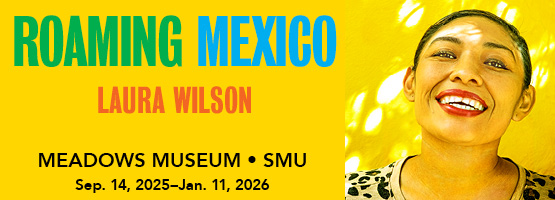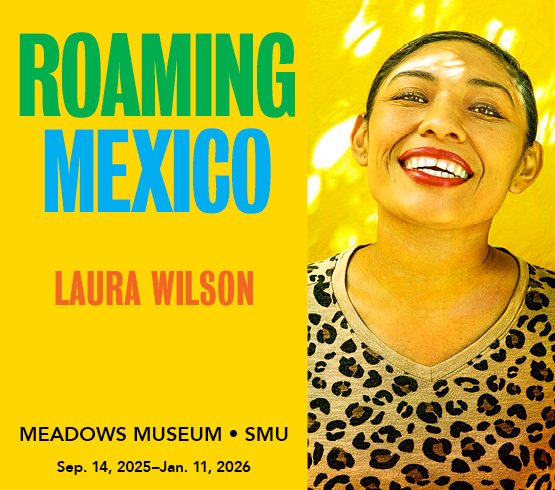The canvas’ title, Sogni Dorati, translates from Italian as “golden dreams.” The link between that and a golden area that anchors the work’s bold structure may appear obvious enough. But North Texas artist Stephen Lapthisophon, who created it, sees more meanings in the title.
Sogni Dorati is one of the most recent works in S, the retrospective of Lapthisophon’s work that runs through Aug. 12 in Dallas’ Conduit Gallery. It helps sum up the artistic threads that run through the show, from Lapthisophon’s going beyond painting’s traditional ingredients—incorporating cloth pieces and coffee in Sogni Dorati, for instance—to his works’ roots in the past. That can mean more than his own past: Lapthisophon thinks Sogni Dorati has “a lot of (Robert) Rauschenberg” in it.
“There’s a kind of free-floating tribute to the past in the whole show,” he says. The present day figures in, too: One work alludes to Archie Shepp, the veteran jazz musician Lapthisophon saluted in a Conduit Gallery show in 2021.
“In many ways, I think of Chicago as home base, because I was there longer than anywhere else,” Lapthisophon says. “I had a thriving art practice in Chicago, and I liked—and still like—many things about it.”
But he gained a foothold in North Texas in the early 2000s, thanks in part to a Conduit Gallery show and a stint with UT Dallas’ South Side Artist Residency. In 2007, Lapthisophon transplanted himself. “After the residency, I was back in Chicago,” he recalls. “I know it’s a bit of a cliche, but I thought of facing another winter and said, ‘I think I can use a change.’”
Lapthisophon taught some classes at UT Dallas and Southern Methodist University. But his headquarters as an educator has been UT Arlington, where he taught for 15 years until his retirement last spring—a milestone that the current Conduit Gallery show commemorates.
More-established artists in Chicago helped him as he started out, Lapthisophon recalls, so “I have tried to be an encouraging person” to students. Outside the teaching studios, he spearheaded art exhibitions—notably in West Dallas’ then-neglected Trinity Groves neighborhood.

1 ⁄7
Stephen Lapthisophon
E.D, 2017
acrylic & mixed media on paper
30h x 22w in

2 ⁄7
Stephen Lapthisophon
Sphere, 2003
oil stick, latex & coffee grounds on paper
35h x 23w in

3 ⁄7
Stephen Lapthisophon
Untitled, 2011
print on paper
30h x 22w in
Unique

4 ⁄7
Stephen Lapthisophon
Enofriulia, 2011
ink, spray paint, latex & coffee grounds on paper 40h x 26w in

5 ⁄7
Stephen Lapthisophon
Untitled, 2011
print on paper
30h x 22w in

6 ⁄7
Stephen Lapthisophon
Window, 2003
ink photo transfer on archival paper
22h x 30w in

7 ⁄7
Stephen Lapthisophon
Sogni Dorati, 2020
collage, enamel, acrylic, spray paint, oil stick, coffee, ink, spray paint & fabric on canvas
60h x 80w in
Teaching has benefited him in return. “Thinking about issues and talking about things gave me some good energy,” Lapthisophon says. His own work has ranged from installations, performances and book-making to paintings and works on paper. The Conduit Gallery show focuses on the last two, surveying works reaching as far back as 2003.
Some of his works incorporate snippets of text, either legible or partly obscured, in the midst of abstraction. When markings interfere with words, as in the mixed-media work Cruel—which sets off dollops of red against patches of grey and black—“that cancellation of the text (is) like a kind of forgetting,” Lapthisophon says.
On the other hand, in an untitled print from 2011, scrawled words—saffron, mussels, clams, rice—stand out clearly. Yes, Lapthisophon is listing ingredients of paella. He thinks of food as more than just a slice of his own story.
He isn’t talking just about subject matter. The label for Window from 2013 lists its materials as latex, ink—and pigmented chicken fat. Lapthisophon came up with that last ingredient because of “not wanting to dump a bunch of grease down the sink,” he says with a laugh.
“I was collecting it in a can, and I liked the way it looked,” he recalls. “I realized that this is every bit as much of a binder as linseed oil (which artists often mix with paint). I had a bunch of dry pigment, so I played with dumping some of the pigment in the chicken fat. It had a viscous, gloopy quality that I liked a lot.”
Bacon fat has worked for him, too. “Sometimes I like just jarring people out of their preconceptions,” Lapthisophon says. When people want to know about a painting, he continues, they may ask whether it’s oil or acrylic. He imagines his reply: “Well, actually, it’s fabric and spray paint, coffee and beet juice.”
He remembers a comment he hears from Conduit Gallery owner Nancy Whitenack. “She says, ‘You just want to get people to get up and put their noses in it,’” he says. “Yeah, I want people to look closely.” One of his teachers at UT Austin “used to talk about variety in surface, and I just stuck with it.”
Lapthisophon has another reason for drawing close to the paper or canvas as he works: Because of an optic-nerve malady that struck him in 1994, he’s legally blind.
“I can see a lot, obviously, but there’s a lot I can’t see,” he says. “I don’t drive. I have to use magnifiers to read. I use all the magnification stuff on the computer. … I don’t use a smartphone, because I can’t see the screen or keyboard very well.”
When it comes to creating art, though, “I feel perfectly fine with that,” Lapthisophon says. “I can get close enough that I can see what I’m doing. Also .. I’ve been doing it long enough (that) I kind of know what I’m going to produce—what effect is going to happen if I do this or that.”
The obvious next question is: Did visual impairment affect his style, themes or interests as an artist?
Between his work before and his work after, “there’s really not a lot of difference,” Lapthisophon says with a laugh. “A lot of it looks the same. I feel like, in some ways, I’ve been doing the same thing for a long time. I guess I would say my approach is pretty constant.”
-STEVEN BROWN





